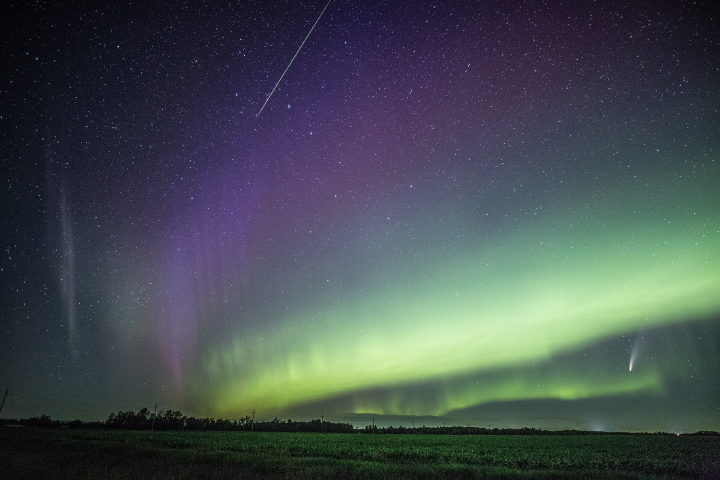

Since NASA Earth Observatory started publishing images in 1999, the archive has grown to contain more than 17,000 stories. This week, Image of the Day stories highlight this robust archive with a look back at images acquired “on this day.” Our brief retrospective illustrates that Earth observations are more than just snapshots in time; together they allow us to better understand—and marvel at—our diverse, changing planet. This story was originally published with the text below on July 18, 2020.
Look up toward the stars this month, and you just might spot the brightest comet to grace Northern Hemisphere skies in decades. In July 2020, comet NEOWISE (short for C/2020 F3 NEOWISE) has thrilled skywatchers in North America, in Europe, and in space. If you don’t spot the comet this time around, you won’t get another chance. It has a long, elliptical orbit, so it will be approximately 6,800 years before NEOWISE returns to the inner parts of the solar system.
The photo above and the time-lapse video below show NEOWISE as viewed from the International Space Station (ISS) on July 5, 2020. An astronaut shot more than 340 photos as the comet rose above the sunlit limb of Earth while the ISS passed over Uzbekistan and central Asia.
Comet Neowise has a nucleus measuring roughly 5 kilometers (3 miles) in diameter, and its dust and ion tails stretch hundreds of thousands to millions of kilometers while pointing away from the Sun. The icy visitor was discovered on March 27, 2020, by NASA’s Near-Earth Object Wide-field Infrared Survey Explorer (NEOWISE) spacecraft as the comet was headed toward the Sun. The comet made its closest approach to the Sun on July 3, and then turned back toward the outer solar system.
Comets are made of frozen leftovers from the formation of the solar system roughly 4.6 billion years ago. The masses of dust, rock, and ice heat up when approaching the Sun; as they get closer, they spew gases and dust into a glowing head and tail. Satellite data indicate the NEOWISE has a dust tail and possibly two ionized gas tails. The comet is made visible by sunlight reflecting off of its gas emissions and dust tail.
“It’s quite rare for a comet to be bright enough that we can see it with the naked eye or even just with binoculars,” said Emily Kramer, a co-investigator of the NEOWISE satellite, in a NASA Science Live webcast. “The last time we had a comet this bright was Hale-Bopp back in 1995-1996.”

The photo above shows the comet (bottom-right) on July 14, 2020, against the backdrop of a green aurora in western Manitoba, Canada. The bright streak at the top is a meteor. The purple, ribbon-like structure is an aurora-like structure called STEVE (short for Strong Thermal Emission Velocity Enhancement), a phenomenon that was recently discovered with help from citizen scientists. Donna Lach, the photographer and an avid participant in the Aurorasaurus project, observed the scene for three hours and said the comet even out-shined the brilliant aurora at times.
Astronaut photograph ISS063-E-39888 was acquired on July 5, 2020, with a Nikon D5 digital camera using a focal length of 28 millimeters. It is provided by the ISS Crew Earth Observations Facility and the Earth Science and Remote Sensing Unit, Johnson Space Center. The image was taken by members of the Expedition 63 crew. The image has been cropped and enhanced to improve contrast, and lens artifacts have been removed. The International Space Station Program supports the laboratory as part of the ISS National Lab to help astronauts take pictures of Earth that will be of the greatest value to scientists and the public, and to make those images freely available on the Internet. Additional images taken by astronauts and cosmonauts can be viewed at the NASA/JSC Gateway to Astronaut Photography of Earth. Time-lapse animation by Sara Schmidt of the Earth Science and Remote Sensing group at NASA JSC. Aurora and comet photograph by Donna Lach, used with permission. Caption by Kasha Patel.